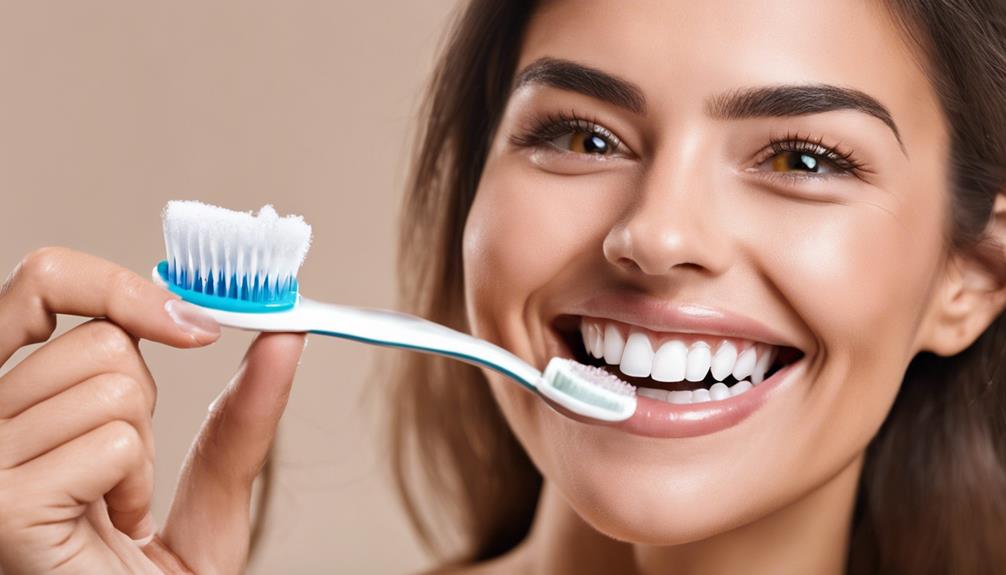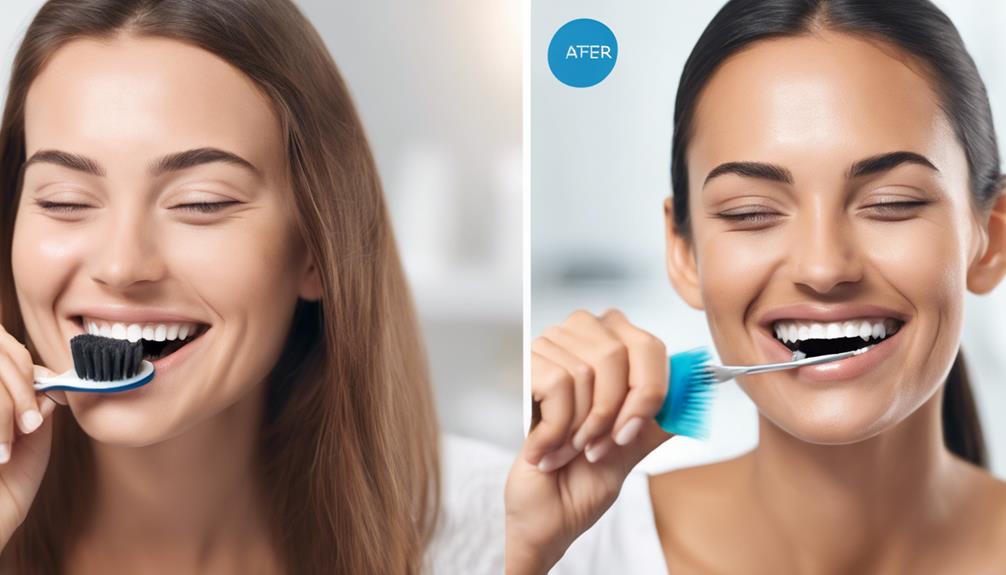How to Naturally Brighten Your Teeth: Beauty Tricks for a Whiter Smile
To achieve a brighter smile without harsh chemicals, consider incorporating natural teeth whitening methods into your beauty routine. From oil pulling with coconut oil to utilizing the stain-removing properties of activated charcoal, these tricks offer a safe and effective way to enhance your smile. Discover how simple ingredients like baking soda and apple cider vinegar can work wonders for your teeth. Stay tuned to uncover the secrets of achieving a whiter and healthier smile through these natural beauty hacks.
Oil Pulling for Oral Health
Looking to enhance your oral health naturally? Consider incorporating oil pulling into your daily routine. This ancient Ayurvedic practice involves swishing oil around in your mouth to improve oral hygiene.
Among the various oils used, coconut oil stands out for its numerous benefits. Coconut oil is known for its antimicrobial properties, making it effective in reducing harmful bacteria in the mouth. This can help prevent plaque buildup, gingivitis, and bad breath.
The lauric acid present in coconut oil has been shown to have anti-inflammatory and antioxidant effects, promoting overall gum health.
To practice oil pulling with coconut oil, simply take a tablespoon of oil and swish it around in your mouth for about 15-20 minutes. Remember not to swallow the oil as it collects bacteria and toxins from your mouth. Afterward, spit it out and rinse your mouth with water before brushing your teeth as usual.
Incorporating this Ayurvedic practice into your daily routine can contribute to improved oral health and a brighter smile.
Turmeric Paste for Whitening
Enhancing the brightness of your teeth can be achieved naturally through the use of turmeric paste for whitening. Turmeric, a spice known for its vibrant color and numerous health benefits, can also help whiten your teeth effectively.
Turmeric Paste for Whitening
Turmeric offers various benefits, including its antimicrobial properties that can help combat oral bacteria and its anti-inflammatory effects that may aid in reducing gum inflammation. However, there are precautions to consider when using turmeric for teeth whitening.
| Turmeric Benefits | Turmeric Precautions | How to Use |
|---|---|---|
| – Antimicrobial properties | – Staining potential on surfaces | – Mix turmeric with water or coconut oil to form a paste |
| – Anti-inflammatory effects | – Potential to cause yellow stains on dental work | – Gently brush the paste onto your teeth |
| – Natural teeth whitener | – Can temporarily stain your skin | – Leave on for a few minutes before rinsing thoroughly |
When using turmeric paste, be mindful of the staining potential and ensure proper rinsing to prevent any discoloration.
Baking Soda as a Gentle Abrasive
To further brighten your teeth naturally, consider utilizing baking soda as a gentle abrasive. Baking soda is a versatile ingredient that can be used in various DIY remedies to help whiten your teeth effectively. Here's how you can use it:
- Baking Soda and Water Paste: Create a paste by mixing baking soda with water to form a thick consistency. Gently brush this paste onto your teeth for a few minutes before rinsing thoroughly. This method helps remove surface stains and plaque buildup.
- Baking Soda and Lemon Juice Mixture: Combine baking soda with lemon juice to create a paste. Lemon juice acts as a natural bleaching agent, enhancing the whitening properties of baking soda. Use this mixture sparingly due to the acidic nature of lemon juice.
- Baking Soda and Coconut Oil Blend: Mix baking soda with coconut oil to form a paste. Coconut oil has antimicrobial properties that can benefit oral health while the baking soda gently polishes the teeth. This blend can help freshen breath and whiten teeth simultaneously.
Apple Cider Vinegar Rinse
For a natural approach to improving the brightness of your teeth, consider incorporating an apple cider vinegar rinse into your oral care routine. Apple cider vinegar is known for its vinegar benefits, which include natural acidity that can help whiten teeth by breaking down stains. The acetic acid in apple cider vinegar has been shown to have antibacterial properties, which may contribute to a healthier mouth environment.
To use apple cider vinegar as a rinse, mix one part vinegar with two parts water. Swish this solution around in your mouth for about 30 seconds to a minute, being careful not to swallow it. After rinsing, be sure to brush your teeth to remove any remaining acid from your mouth.
It's important to note that while apple cider vinegar can help brighten teeth, excessive use can erode tooth enamel due to its natural acidity. Therefore, it's recommended to use this rinse sparingly, perhaps a few times a week, to avoid damaging your teeth.
Activated Charcoal for Stains
When looking to address stubborn stains on your teeth, consider incorporating activated charcoal into your oral care routine. Activated charcoal is known for its ability to effectively remove stains and brighten teeth naturally. Here are some benefits of using activated charcoal for a whiter smile:
- Charcoal Toothpaste Benefits: Charcoal toothpaste containing activated charcoal can help remove surface stains on teeth, resulting in a brighter smile over time.
- Homemade Charcoal Toothpaste: You can create your own charcoal toothpaste at home by mixing activated charcoal powder with a small amount of water to form a paste. This homemade remedy can be a cost-effective way to whiten your teeth.
- Activated Charcoal Masks & Skincare Benefits: Apart from oral care, activated charcoal is commonly used in skincare products like masks. Its absorbent properties help draw out impurities and toxins from the skin, making it a versatile ingredient for overall beauty routines.
Strawberries for Natural Brightening
Enhance your natural brightening routine with the surprising power of strawberries. These delicious fruits aren't only a tasty snack but can also contribute to a brighter smile. Strawberries contain malic acid, which acts as a natural astringent to remove surface tooth discoloration.
To create a DIY whitening treatment using strawberries, you can make a simple strawberry paste at home.
Mash up a ripe strawberry and mix it with a pinch of baking soda to form a paste. Apply this paste to your teeth using a toothbrush or your finger, and gently scrub for a few minutes.
The malic acid in the strawberries helps to break down stains, while the baking soda acts as a mild abrasive to polish your teeth.
Crunchy Fruits and Veggies Benefits
Packed with vitamins and minerals, crunchy fruits and veggies offer more benefits beyond just satisfying your hunger. When it comes to naturally brightening your teeth, these foods can play a significant role in enhancing your smile. Here are some benefits of including citrus fruits and leafy greens in your diet:
- Citrus Fruits, Benefits:
- Citrus fruits like oranges and lemons are high in vitamin C, which promotes healthy gums and can help prevent gum disease.
- The natural acids in citrus fruits can help whiten teeth by breaking down plaque and removing surface stains.
- The act of chewing on citrus fruits can stimulate saliva production, which aids in washing away food particles and bacteria that can lead to tooth decay.
- Leafy Greens, Advantages:
- Leafy greens such as spinach and kale are rich in minerals like calcium, which is essential for strengthening tooth enamel.
- The high fiber content in leafy greens can help scrub teeth clean and remove plaque buildup.
- The chlorophyll in leafy greens has been shown to neutralize bad breath and leave your mouth feeling refreshed.
Green Tea for Plaque Prevention
Green tea has long been hailed for its numerous health benefits, and one of its notable advantages lies in its ability to prevent plaque buildup on your teeth.
The benefits of green tea for plaque prevention are backed by scientific evidence. Green tea contains compounds called catechins, specifically epigallocatechin-3-gallate (EGCG), which have been shown to inhibit the growth of bacteria in the mouth.
These bacteria are responsible for the formation of plaque, which can lead to cavities and gum disease.
Hydrogen Peroxide Rinse for Whitening
To effectively whiten your teeth at home, consider incorporating a hydrogen peroxide rinse into your oral care routine. Hydrogen peroxide is a common ingredient in many whitening products due to its ability to remove stains and lighten teeth. Here are some tips to help you use hydrogen peroxide safely and effectively:
- Dilute the hydrogen peroxide: Mix equal parts of hydrogen peroxide and water to create a safe and gentle rinse for your teeth.
- Use it sparingly: Limit the use of hydrogen peroxide rinse to a few times a week to prevent sensitivity and damage to your enamel.
- Avoid combining with lemon juice: While lemon juice is often touted for its whitening properties, combining it with hydrogen peroxide can be harmful to your teeth. The acidic nature of lemon juice can erode enamel, leading to potential risks like increased sensitivity and tooth decay.
Frequently Asked Questions
Can I Combine Multiple Natural Remedies for Whiter Teeth?
When combining natural remedies for whiter teeth, consider their effectiveness and possible sensitivity concerns. Mixing ingredients like baking soda, coconut oil, and strawberries can enhance results, but be cautious of overuse to prevent tooth sensitivity.
Is It Safe to Use These Methods if I Have Sensitive Teeth?
When dealing with tooth sensitivity, it's crucial to be cautious about alternative methods for whitening. Consider gentler options like baking soda or activated charcoal. Always consult a dentist to ensure your teeth stay healthy and pain-free.
How Often Should I Use These Natural Remedies for Best Results?
For best results, use natural remedies consistently. The frequency of use should align with your dental needs. Establishing a routine and sticking to it is key. Remember, consistency is crucial in achieving a brighter smile naturally.
Can Children Use These Natural Teeth Whitening Methods?
When it comes to child safety and natural methods for whitening options for kids' teeth, it's essential to consult a pediatric dentist. Natural remedies like baking soda and fruit peels may not be suitable for young teeth.
Are There Any Side Effects to Using These Natural Remedies Long-Term?
Long-term use of natural remedies for teeth whitening may pose risks to your tooth enamel. Continuous exposure to acidic substances like lemon juice or abrasive compounds like baking soda can increase erosion risks, leading to potential long-term effects on your oral health.
Conclusion
In conclusion, these natural beauty tricks offer safe and effective ways to naturally brighten your teeth for a whiter smile. While some may be skeptical of the effectiveness of these methods, numerous studies have shown their benefits in reducing bacteria, removing stains, and promoting oral health. Give these natural remedies a try and see the difference for yourself in achieving a healthier and brighter smile without harsh chemicals.














